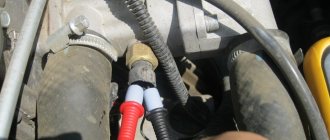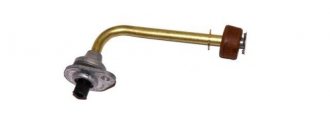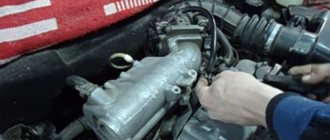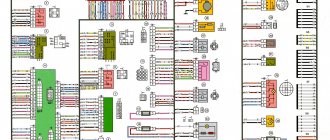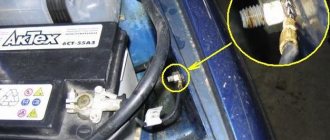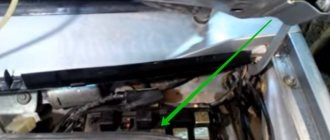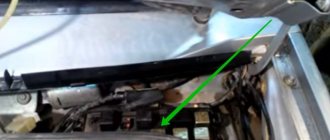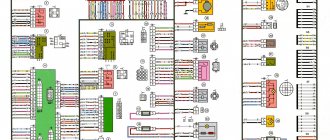Print this article Font size 16
It cannot be said that the VAZ 2114 is a very modern car filled with electronics. However, the list of sensors used that are connected to the electronic control unit is quite impressive on the fourteenth.
Each of these devices is responsible for certain functions and collects data transmitted to the main computer of the car. This way, the ECU controls the entire process and makes appropriate changes, so that the driver does not have to look for the reasons for the failure or insufficiently efficient operation of a particular unit.
Main signs of failure
If the crankshaft sensor becomes unusable, the shape and magnitude of the output signal will be disrupted. The microcontroller polls the device for no more than 5 minutes. If there is no signal from the sensor, the control unit is switched to emergency operation mode. Then only the sensor on the crankshaft is analyzed, fuel injection is supplied to two cylinders simultaneously. Gasoline consumption increases by 10%. The main signs of a phase sensor failure:
- Significant increase in gasoline consumption.
- Deterioration of the dynamic characteristics of the car.
- Difficulty starting the engine. In the best case, it will start in 3-5 seconds.
- The Check Engine light comes on on the dashboard.
- Violation of ECU and system diagnostics.
- Errors P0343 or P0340 appear on the on-board computer.
Malfunctions of the phase sensor on the VAZ-2114 (8 valves) lead to exactly this engine behavior. It must be taken into account that malfunction can also occur if the timing belt breaks or the marks are set incorrectly. And also with excessive wear of the gears on the camshaft and crankshaft.
How to check DPKV
When it is suspected that the crankshaft position sensor is malfunctioning, it is necessary to dismantle the device and inspect it.
Causes and symptoms of sensor malfunction:
- the device body is cracked due to mechanical stress, the core or contacts are damaged;
- due to scuffing of the journal, the opening in the bearing has increased;
- the surface of the components is damaged, scratches or cracks appear;
- the sensitive element has failed over time;
- the crankshaft liners are melted;
- a manufacturing defect appeared;
- the gap between the crankshaft and the liner has increased;
- the working holes wear out or the key is cut off.
Checking the DPKV is performed with a multimeter. The device is capable of measuring the resistance of the core winding. This is done as follows:
- the multimeter switches to the required position, the switch is set to 2 kOhm;
- the contact group is located on the DPKV terminals;
- if the readings are from 500 to 800 Ohms, then the device is working properly;
- to obtain information about inductance, the multimeter is switched to the appropriate mode;
- If the sensor is in perfect order, then we remove the level of about 400 mH.
Often the terminals become dirty or oxidized. They are pre-cleaned with sandpaper. Multimeter readings do not give a 100% guarantee; a dismantled sensor may be faulty and give correct readings only in this form. While driving and the temperature rises, the readings may change. This happens if a short circuit occurs between the turns of the winding. We find the exact inductance and resistance indicators in the device data sheet.
The crankshaft sensor will also have to be replaced if the insulation is faulty. To check it, you will have to use a megohmmeter:
- the device is set to 500 V;
- one terminal is located on the contact, the second - on the body of the device being tested;
- The resistance of a working device fluctuates between 20–25 MOhm.
Replacing the position sensor can solve the problems that have arisen. These devices cannot be repaired, but quite often the cause of problems is contamination, which is not difficult to eliminate in a timely manner.
The car owner must ensure that the gap between the pulley and the device does not exceed one millimeter. A caliper is used for measurement.
How to replace it yourself
Preparatory stage:
- Open-end wrench set to “19”;
- Rags;
- Additional lighting as needed;
- New "measuring device".
Replacement algorithm:
- We install the VAZ 2114 in the perimeter of the repair area;
- We turn off the engine, open the hood;
- We provide priority safety measures: block the rear row of wheels with wheel chocks, squeeze the parking brake;
- Remove the terminals from the DTOZH, unscrew the sensor with a key;
- We replace the device with a new one, screw it in, and put on the power terminals again.
We turn the key in the ignition, activate it, and check the functionality of the equipment. Add the missing amount of antifreeze as needed.
Where are they located?
But knowing about their presence in your VAZ 2114 car is not enough. In case of problems, when the electronic control unit receives incorrect data from signaling devices, they have to be changed.
Whatever one may say, every sensor that has ceased to function properly and transmit correct data on the state of the systems to the electronic control unit must be replaced. Almost all sensors cost no more than a few hundred rubles. But even low cost and small size do not indicate the uselessness of these devices. Change devices promptly.
To do this, you need to understand how to get to this or that sensor. Therefore, we invite you to familiarize yourself with the location of key alarm and measurement devices.
On-board computer errors
Error number P0343 very often appears after oxidation of contacts or when the electrical wiring is broken. You can independently diagnose the internal combustion engine control system using the simplest scanner that works via the K-line or the OBD-II protocol. But it is better to entrust this work to professionals who have high-quality equipment.
The most accurate check of the VAZ-2114 phase sensor (8 valves) is to install a known-good device. But keep in mind that you also need to purchase sensors for 8-valve engines. Those installed on 16-valve engines have a different design. Their output signal is different.
The sensor is the main signal for action
Let's start with the simplest one, which each of you is familiar with - a speed sensor. The injector carries out most of the processes for stable operation of the car, so the main part of the measuring instruments interacts with it, the speed sensor is no exception. If you have previously owned Zhiguli cars of older models, then I advise you not to apply your knowledge to this model.
Here, in addition to its main function, which is to pulse transmit the current speed to the speedometer, it helps regulate engine operation. The controller built into it regulates the air supply bypassing the throttle valve, which helps achieve a more stable idle. Therefore, if it is unstable, and fuel consumption increases, engine thrust decreases, or the speedometer does not function well, the speed sensor may be to blame. Its location has not changed - on the gearbox.
The temperature sensor is undoubtedly one of the main “alerts”, because it warns about engine overheating. I will say from my own experience, and many of you probably know, that there can be a variety of reasons. Either the pump or the pipes are leaking, the thermostat is “closed”, or maybe the fan. All this leads to an increase in the temperature of the coolant, which means overheating.
Such a measuring device will warn you about an increase in the degree of antifreeze, thereby saving the engine from sad consequences. You need to constantly monitor him. If you didn’t miss the moment and installed a broken unit, you can find it on the thermostat. This is one of those measuring instruments that has not changed compared to previous car models.
Oxygen sensor (lambda probe)
Oxygen sensor
Installed in the exhaust pipe of the exhaust gas system. The oxygen contained in the exhaust gases creates a potential difference at the sensor output, varying from approximately 0.1 V (a lot of oxygen - a lean mixture) to 0.9 V (a little oxygen - a rich mixture). Based on a signal from the oxygen sensor, the controller adjusts the fuel supply to the injectors so that the composition of the exhaust gases is optimal for the efficient operation of the converter (oxygen sensor voltage is about 0.5 V).
For normal operation, the oxygen sensor must have a temperature of at least 360°C, so for quick warm-up after starting the engine, a heating element is built into it. The controller constantly supplies a stabilized reference voltage of 0.45 ± 0.10 V to the oxygen sensor circuit. Until the sensor warms up, the reference voltage remains unchanged. In this case, the controller controls the injection system without taking into account the voltage at the sensor. As soon as the sensor warms up, it begins to change the reference voltage. Then the controller turns off the heating of the sensor and begins to take into account the signal from the oxygen sensor.
The sensing element of the oxygen sensor is located in the exhaust gas stream. When the sensor reaches operating temperatures exceeding 360 degrees. C, it begins to generate its own emf, proportional to the oxygen content in the exhaust gases. In practice, the DC signal (with a closed feedback loop) is a rapidly changing voltage, fluctuating between 50 and 900 millivolts. The change in voltage is caused by the fact that the control system constantly changes the composition of the mixture near the stoichiometry point; the DC itself is not capable of generating any alternating voltage.
The output voltage depends on the oxygen concentration in the exhaust gases in comparison with the reference data on the oxygen content in the atmosphere coming from the sensor design element that serves to determine the atmospheric oxygen concentration. This element is a cavity connected to the atmosphere through a small hole in the metal outer casing of the sensor. When the sensor is in a cold state, it is not able to generate its own EMF, and the voltage at the DC output is equal to the reference (or close to it).
To speed up the heating of the sensor to operating temperature, it is equipped with an electric heating element. There are sensors with constant and pulsed power supply to the heating element; in the latter case, heating of the DC is controlled by the ECU. The electronic control unit constantly supplies a stable reference voltage of 450 millivolts to the sensor circuit.
An unheated sensor has a high internal resistance and does not generate its own EMF, therefore, the ECU “sees” only the specified stable reference voltage. As the sensor warms up while the engine is running, its internal resistance decreases, and it begins to generate its own voltage, which overlaps the stable reference voltage supplied by the ECU. When the ECU “sees” the changing voltage, it knows that the sensor has warmed up and its signal is ready to be used to regulate the mixture composition.
The oxygen sensor used in serial injection systems is not capable of recording changes in the mixture composition that differ markedly from 14.7:1, due to the fact that the linear portion of its characteristic is very “narrow” (see graph above in the text). Beyond these limits, the lambda probe almost does not change the voltage, that is, it does not register changes in the composition of the exhaust gas.
On VAZ cars of previous modifications (1.5 l.) in Euro-2 systems, the BOSCH 0 258 005 133 sensor was used. In Euro-3 systems, it was used as the first DC installed before the catalyst. The second DC, to control the content of harmful emissions, after the catalyst, a sensor with a “reverse” connector is installed (although there are also cars with the same ones). In new 1.5/1.6 liter cars with the Bosch M7.9.7 and January 7.2 injection system, produced since October 2004, the BOSCH sensor 0 258 006 537 is installed. See the photographs for external differences. The new DC has a ceramic heater, which allows it to significantly reduce the current it consumes and reduce the warm-up time.
To replace failed original lambda probes, Bosch produces a special series of 7 universal sensors that cover almost the entire range of standard sensors.
Speed sensor
Speed sensor
The operating principle of the speed sensor (DS) is based on the Hall effect. The sensor outputs voltage pulses to the controller with a frequency proportional to the rotation speed of the drive wheels. Speed sensors differ in the connection connectors to the harness block. The square connector is used in BOSCH systems.
The sensor with a round connector is used in the January 4 and GM systems. All sensors are 6-pulse, that is, they produce 6 pulses per revolution of their axis. The 10-pulse sensor is used for Samar carburetor trip computers. The speed sensor signal is used by the control system to determine the fuel cut-off thresholds, as well as to electronically limit the vehicle speed (in new control systems).
In those models that have one, you need to install the speedometer drive into the gearbox very carefully; at the slightest misalignment, the plastic teeth of the speedometer drive drive gear will wrinkle and complete disassembly of the gearbox is inevitable.
When the speedometer needle begins to spontaneously deviate within a fairly wide range, regardless of speed, it’s time to change the speed sensor.
The output voltage of the low level pulse should be no more than 1V, and the high level pulse should be no less than 5V.
Full list of VAZ 2114 sensors: name and location
!! The injection engine installed on the fourteenth has a “brain” - an electronic engine control unit. In order to be able to regulate the operation of the power unit, the electronics must constantly monitor all changes that accompany the operation of the motor. For this, VAZ 2114 sensors are used, which we will talk about in this article.
From the material you will learn what sensors are installed on the VAZ 2114 (the information is also relevant for the VAZ 2113 and VAZ 2115), their locations, functionality and features of each device.
Sensors help the motorist (their operation can be seen on the indicators and lights of the instrument panel or BC)
Signs of a Hall sensor malfunction
Hall sensor malfunctions manifest themselves in different ways. Even an experienced technician will not always immediately identify the cause of engine problems.
Here are some of the most common symptoms:
- The engine starts poorly or does not start at all.
- At idle, the engine runs rough and jerky.
- The car may jerk when driving at high speeds.
- The power unit stalls while driving.
If one of these signs appears, you must first check the serviceability of the Hall sensor.
Also, do not exclude other malfunctions of the ignition system found in cars.
Idle air control (IAC)
Idle speed control
The idle air control (IAC) serves to maintain the set engine speed at idle by changing the amount of air supplied to the engine when the throttle is closed. The IAC is located on the throttle pipe and is an anchor-type stepper motor with two windings. When an impulse is applied to one of them, the needle takes one step forward, and to the other, a step back.
Through a worm gear, the rotational movement of the stepper motor is converted into a linear movement of the rod. The conical part of the rod is located in the air supply channel to provide control of the engine idle speed. The regulator rod extends or retracts depending on the control signal from the controller.
The idle speed control regulates the idle speed of the crankshaft by controlling the amount of air supplied bypassing the closed throttle valve. In the fully extended position (the fully extended position corresponds to “0” steps), the conical part of the rod blocks the air supply bypassing the throttle valve. When opening, the valve provides air flow proportional to the movement of the stem (number of steps) from its seat. A fully open valve position corresponds to 255 steps of stem movement. On a warm engine, the controller, by controlling the movement of the rod, maintains a constant crankshaft speed at idle, regardless of the engine condition and load changes.
In Mikas systems, a slightly different name is more often used - Additional Air Regulator (ADV). The RDV has a different design: instead of a stepper motor, a torque motor is used, which rotates the locking element at a certain angle proportional to the voltage.
Supply voltage range V: 7.5-14.2 for РХХ212-1148300-02 (Produced by KZTA) and РХХ212-1148300-01 (Produced by Pegas OJSC, Kostroma)
Testing
Turn off the ignition. Disconnect the harness connector from the regulator. Using a multimeter, check the resistance of the IAC windings. The resistance between the contacts of the idle air control system A and B, and C and D should be 40-80 Ohms. If not, replace the IAC. If yes, check the resistance between contacts B and C, A and D. The device should show infinity (open circuit). If not, replace the IAC. If so, the IAC circuit is ok.
TPS (Throttle Position Sensor)
TPDZ
Mounted on the side of the throttle pipe and connected to the throttle shaft. The sensor (TPS) is a potentiometer, one end of which is supplied with a plus supply voltage (5 V), and the other end is connected to ground. From the third terminal of the potentiometer (from the slider) there is an output signal to the controller.
When the throttle valve is turned (by operating the control pedal), the voltage at the sensor output changes. To check the functionality of the sensor, measure the voltage at this contact with the damper closed. It should be within 0.3-0.7 V (0.7 is better).
When the damper opens, the voltage at the sensor output increases and when the damper is fully open it should be more than 4 V. By monitoring the sensor output voltage, the controller adjusts the fuel supply depending on the throttle opening angle (i.e. at the driver’s request). The throttle position sensor does not require any adjustment because the controller independently determines the minimum voltage of the sensor and takes it as the zero mark.
There are also new type NON-CONTACT sensors produced by Kursk. TU 4591-034-00225331-2002. Since 2003, these have also been installed.
Video: VAZ 2114 sensors - what they are and what they do
Signaling devices called sensors are installed in order to inform the driver or some control device about changes occurring during the operation of the car or about the state of the corresponding unit or system, as well as to signal in case of failures or emergency conditions in the car. Therefore, the driver must have a good understanding of the operating principle and location of the sensors on the VAZ 2114.
- The oil level has dropped significantly;
- the oil filter is clogged;
- the oil pump has failed;
- oil pressure sensor is faulty;
- The wiring is faulty or the oil pressure has dropped due to leaks.
On an eight-valve engine, the sensor is located on the right side below the valve cover in the cylinder head. On a sixteen-valve engine - on the left end of the camshaft bearing housing.
Where is the coolant temperature sensor located on the VAZ 2114
For proper operation, ensuring the collection and transmission of optimally accurate indicators, the DTOZH must be located in direct contact with the measured medium, that is, it must be immersed in the coolant.
Let's look at a temperature sensor using the example of one of the cars in the Lada model range.
The cooling system of VAZ cars is a complex of the following parts:
- heating and cooling radiators;
- fan;
- pump;
- expansion tank;
- coolant temperature sensor.
The measuring device, located between the thermostat and the cylinder head, consists of a resistor and is connected to the control unit by two wires.
The principle of operation of the sensor and its features
In its operation, the sensor uses the physical Hall effect, discovered in the 19th century. However, they began to use it only in the 70-80s of the last century, when automakers began to switch from contact ignition systems to electronic ones.
The principle of operation of the sensor is quite simple. As the motor shaft rotates, metal blades pass through slots in the motor housing. It gives an electrical impulse to the switch, as a result of which the latter unlocks the transistor and supplies voltage to the ignition coil. It, in turn, converts the low-voltage signal into a high-voltage one and supplies it to the spark plug.
Structurally, the sensor has three contacts:
- for connection to “ground” (car body);
- to connect voltage with a “+” sign and a value of about 6 V;
- to supply a pulse signal from it to the switch.
The advantages of using a Hall sensor in electronic ignition systems are two main factors - the absence of a contact group (which constantly burns out), as well as a higher voltage on the spark plug (30 kV versus 15 kV).
Since Hall sensors are also used in braking and anti-lock braking systems and tachometer operation, the device performs the following additional functions for the car:
- increases engine performance;
- speeds up the functioning of all machine systems.
As a result, the ease of use of the car, as well as its safety, increases.
Hall sensor for VAZ 2107
Hall sensor for VAZ 2109
Hall sensor for VAZ 2110
Engine management system
In general, the entire engine control system consists of two components:
By “brains” we mean an electronic control unit, or in short “ECU”, “brains”, “computer”. As they were produced, injection VAZs were equipped with different ECU models - Bosch, January, Avtel/Itelma. To learn more about the brains, the main problems, which brains were installed in certain years, the possibility of chip tuning, read the detailed article - ECU. What it is?
The brains take readings of the current state from the sensors, analyze and control the operation of the engine using the same sensors. Now let's talk about the sensors themselves that are involved in engine operation:
- Crankshaft position sensor (CPS) - serves to synchronize engine operation with the operation of the ECU, works on the principle of induction. In the event of a malfunction, the car does not start well, does not pull, ... More details in the corresponding article.
- Camshaft position sensor (CPR) - often called the “Phase sensor”. Serves to determine phased injection. It is possible to work with a faulty sensor. In details .
- Throttle position sensor (TPS), or gas pedal position sensor (if the gas pedal is electronic, installed since 2011). As for the DPZ, it is paired with the IAC. TPS determines the degree of opening of the throttle assembly. If this sensor is faulty, then there is no response to the gas pedal, the speed increases spontaneously, etc. More details in the corresponding article.
- Knock sensor (DS) - the name speaks for itself. The knock sensor detects engine vibrations (detonation) and accordingly advances the ignition angle. More details in the corresponding article.
- Coolant temperature sensor (Dtozh) - in other words, an engine temperature sensor. Installed on the thermostat, designed to control the temperature conditions of the engine. For more details on how to replace and check, see the article.
- The mass air flow sensor (MAF) is the most expensive sensor, so its failure is extremely unpleasant. Using this sensor, the ECU reads the amount of air consumed. The main malfunctions are lack of traction from the engine, problems with idling. On this site, good informative articles are devoted to this sensor, which you can read.
- Speed sensor (DS) – the speed sensor is primarily designed to measure the speed of the vehicle and is located on the gearbox. But it also has other functions - more on that.
- Oxygen concentration sensor, or simply oxygen sensor (dk) - determines the amount of oxygen in the exhaust system, regulates the mixture of fuel and air. Euro-2 has 1 sensor installed, Euro-3 has two sensors. Very often, after 60 thousand km. The second mileage sensor is disabled by software because With our gasoline it quickly breaks down. However, it can be repaired and replaced. DC is also the cause of many problems, more about this.
- Idle air control (IAC) (until 2011) or an electrically driven throttle valve (since 2011) - this sensor is responsible for stable idling. Allows air into the engine at idle speed, bypassing the TPS. Quite a capricious sensor, we replace it often. The main problem is unstable idle. Often there is a marriage. More about this.
- Electric throttle valve - (E-gas) - the essence is that it is an electronic throttle valve, which is opened not by the gas pedal cable (mechanically), but by the brains (electronically).
- Gas pedal position sensor - (E-gas) - the sensor provides readings of the gas pedal position to the computer, which in turn opens the electronic throttle valve.
As you can see, in general the number of sensors is not large, but believe me, many of them have caused many problems to car owners, so carefully study and use this material.
Ignition module
Ignition module
I’ll say right away: there are no simple tests that can reliably evaluate this element of the ignition system. For the reason that the spark formation process itself cannot be called simple. First, the accumulation of inductive energy in the coil, then saturation, breakdown of the spark gap, the occurrence of an arc, its combustion, and finally, damped oscillations.
Each stage has its own characteristics, characteristics and parameters, everything has its essence and weight. Changes in characteristic quantities: accumulation time, breakdown voltage, combustion voltage, arc burning time and distortion of the shape of damped oscillations provide a lot of information about the health of the coil or module.
All this is clearly visible on the monitor of a motor tester or oscilloscope, and deviations in individual cylinders are clearly visible in comparison. But according to the terms of this topic, we, like most car enthusiasts, have nothing except a control unit and a Chinese tester. Well, no need, we’ll try to get out of it, there are no hopeless situations. Actually, there are only 2 methods worth attention left: Determination of performance by the arrester and the simple replacement method. The first method is often used, but it involves having a spark gap itself, and is based on the fact that a working ignition module should be able to spark a 20mm air gap with any of its terminals. A defective module channel will not be able to do this.
Personally, I like the arrester design with an adjustable or 4-step gap of 5, 10, 15, 20 mm. By running the coil leads one by one, you can see when the weakest one gives up. I will not dwell on this in detail, the designs of arresters and descriptions of the method in the sea network. The method works, although it has certain limitations and requires some experience and skill. Therefore, I would like to focus on the second method - simple substitution, especially since it is the most accessible for car enthusiasts.
This is a really simple method, but there is one point. The ignition module is designed in such a way that it easily develops a voltage of 20 kilovolts at its terminals. When a control pulse is received from the control unit, a high-voltage discharge through explosive wires rushes to ignite the mixture compressed in the cylinder. Question. Where will the charge go if the wire is suddenly broken? (or will be completely absent - for the module this is the same thing) The discharge is looking for a way out, and unfortunately, it quickly finds it. Most often, the module pierces its own insulation with its own energy and begins to “sew” to ground along the shortest current path.
Where the insulation is weakest. The trodden path drains the charge energy onto the ground, as a result, 2 cylinders fail at once. Either 1-4 or 2-3, depending on which wire breakage triggered the insulation breakdown. The insulation may turn out to be good, then a breakdown is possible between the turns of the coil itself, again inside the module. Moreover, a breakdown can cause an interturn short circuit, or it can simply be sewn when the breakdown conditions, even on a serviceable wire, are the most severe. And these are moments of maximum load on the engine, for example, intense acceleration. Another question is which turns will close: if they are extreme, then the channel will fail.
And if they are adjacent, then the coil will lose power, and almost imperceptibly to the eye - the inductance is no longer the same. But this is for the time being. Soon, twitching, adjustments, jerks and dips, idle speed fluctuations, and other troubles will begin. These are not all types of module malfunctions, but the couple listed above indicate that its health largely depends on its operating conditions.
Therefore, in relation to our method, the question is: What will happen if, without checking the serviceability of the explosive wires, you install a known-good ignition module on your car as a replacement, kindly provided by a neighbor? (if one of the wires is broken, and the module is probably fried for this reason) Nothing may happen: your neighbor’s module may turn out to be more powerful than yours, and for the duration of a short test it will cope with the task, breaking through the gap, and you, making a mistake in diagnosis, buy a new one , which will not live long due to a broken wire.
In short, before checking the ignition module by replacing it, be sure to check the condition of the explosive wires. They can be not only the source of deterioration in driving performance, but also the cause of failure of the ignition module itself, which most often happens. Well, about the fact that it is impossible to check the serviceability of the coil and module while the engine is running by removing the explosive wires in turn from each spark plug, you cannot start or even crank the engine with the starter if at least one wire is removed from the module, you cannot use wires of dubious quality, you and so you know.
How to replace the temperature sensor?
You can replace the part yourself without resorting to the help of specialists. For ease of dismantling, it is better to choose a socket wrench or a deep socket with a knob.
Replacement is carried out on a cold engine in the following sequence:
Remove the air filter from the car. It blocks access to the sensor. After replacement, you will need to install the filter in its seat. Disconnect the negative cable from the battery. Necessary to avoid errors in the electronic control unit. Remove the protection located under the power unit. Drain the coolant from the radiator. Disconnect the wires from the sensor
When disconnecting the connector, it is important not to damage the plastic latch. It is necessary to fix the plug and prevent it from spontaneously disconnecting.
- Unscrew and replace the sensor. A 19 mm socket wrench is used. To speed up the work process, you can use a head with a ratchet.
- Reinstall the electrical wiring plug and protection.
- Fill with coolant and warm up the power unit to operating temperature.
Some car owners replace the sensor without draining the coolant. To do this, carefully unscrew the part and quickly replace it with a new one. Thus, during the replacement process, a minimum amount of coolant leaks.
Final inspection of households
To make sure that the DC is fully operational, a diagnostic test should be performed. However, there are several testing options, and each specialist uses either his favorite method or the one that is most effective and easy in a particular situation.
The most common test option is to compare the tester readings with the factory ones. In other words, a multimeter is connected to the DC terminals, and the values on the device are checked. As a rule, if the readings with the DH shutter open are approx. 0.4 V, the sensor is working normally.
Another method is no less popular. It is most often used by car owners who do not carry measuring instruments with them. This method gives the most accurate readings. It is necessary to replace the DC installed in the car with a similar regulator. If the car behaves normally with the new sensor, the engine will not freeze, then the diagnosis has been confirmed - the old DC is no longer suitable.
Some experts recommend diagnosing DH using a simulator. Such a device, often made by hand, is connected to the ignition system. If the spark is supplied normally after this, but before that there was none, the DH is faulty.
To easily replace the DC, you just need to follow the instructions below:
- remove the cover from the distributor;
- turn the crankshaft until the pulley mark coincides with the timing cover mark;
- indicate the position of the distributor rotor (runner);
- dismantle the distributor using appropriate tools;
- remove the pin securing the position of the oil deflector clutch (you can knock it out with a hammer, and pull it out with pliers);
- remove both the coupling and the washer;
- remove the shaft from the distributor body;
- de-energize the DC terminals;
- unscrew the sensor and pull it out through the hole;
- install a new one, assemble everything in reverse order.
Advice. In order for the DC to come out easily, you need to pull back the regulator. This will create a hole through which DH will come out.
It is necessary in order to accurately determine the ignition timing.
It almost never breaks. At the same time, its connectors need to be regularly cleaned of dirt. Usually problems arise due to a break in the wires going to the sensor. Checking is required in situations where a malfunction signal turns on while the engine is running at 3 thousand rpm or more. Installed near the muffler. It determines how much oxygen remains in the exhaust. Its data is necessary in order to properly adjust the fuel supply to the engine. In the presence of oxygen, the proportion of gasoline increases. The computer can only detect complete sensor failure.
We find and fix the problem
Signs of DMRV problems
So:
- The engine does not start;
- Unstable engine operation at idle;
- Engine idle speed is too high or too low;
- “Failures” during acceleration and poor vehicle dynamics;
- Fuel consumption is significantly exceeded.
Diagnostics
In addition to the above symptoms, a malfunction of the flow meter can be detected by the electronic control unit, namely its diagnostic system, which will issue a “CHECK” signal on the instrument panel. Unfortunately, without specialized diagnostic equipment with a 100% guarantee, it is impossible to identify a malfunction of the mass air flow sensor by reading error codes; you will have to contact a service station. Although, this is also controversial advice, since they will most likely offer you to identify the malfunction of the flow meter by replacing it with a known good device, but you can do this with your own hands without outside help. Let’s try to identify a flow meter breakdown in “field” conditions using four methods known to mankind. In general, we read carefully and remember. So, instructions:
The first method is the main one.
We disconnect the wire plug from the sensor and start the engine, the engine speed will rise to at least one and a half thousand per minute, and we’ll move off. If the car has acquired agility that is unusual for it, there is a malfunction of the sensor. Let me explain: the sensor is disabled, which means the ECU supplies the amount of gasoline according to the throttle position (emergency mode), without taking into account the signal from the flow meter.
When replacing the firmware in the ECU, no one will be able to say exactly what the idle speed setting is during emergency operation (method one). Therefore, this nuance is checked as follows: we slip a feeler gauge one millimeter thick under the throttle valve stop. After the speed rises, disconnect the sensor wire connector. The engine stalled - the firmware is to blame, or rather the idle speed adjustment in emergency mode.
The third method is the most accurate.
We turn the tester into DC voltage measurement mode and set the limit to two volts. We connect the probes to the yellow output wire - the plus probe and to the mass colored green wire - the minus probe, located relative to the windshield - the first and third, respectively.
Turn on the ignition, do not start the engine, take readings:
As a rule, the voltage of a working sensor is 0.996 – 1.01
Volt, but during wear it steadily increases:
- the sensor is in good condition at voltages from 1.01 to 1.02 V;
- slight wear: 1.02 – 1.03 V;
- decent mileage, will soon require replacement: 1.03 – 1.04 V;
- to be replaced at 1.04-1.05;
- It is prohibited to operate the sensor at a voltage of 1.05 Volts or higher.
Method number three
Method four, visual.
Using a curved screwdriver, remove the corrugated air duct going to the throttle assembly, and carefully inspect the internal surfaces of the air duct and sensor for the presence of condensate and oil; they should be dry and clean.
Using a ten key, unscrew the two screws and remove the sensitive element.
Checking the O-ring
As can be seen in the photo, on its front part there is a rubber sealing ring that prevents the leakage of foreign air into the intake manifold in addition to the sensor
Please note that when the integrity of the ring is destroyed, a small layer of dust forms on the sensor mesh. This is also one of the main reasons for “killing” the flow meter
In addition to the above methods, it is necessary to mention such factors as the lack of on-board power supply and unqualified maintenance (even innocent wiping of the working surfaces with a cotton swab can lead to damage to the unit). This unit is considered non-maintainable and non-repairable.
Mass air flow sensor
Mass air flow sensor
BOSH 0 280 218 004, 037, 116
To assess the condition of the sensor with acceptable accuracy, you need a few minutes, a 10-mm open-end wrench, a shaped screwdriver and a Chinese tester with a fresh battery.
1. Turn on the tester in DC voltage measurement mode and set the measurement limit to 2 Volts. We find in the sensor connector a yellow wire - output (closest to the windshield) and a green wire - ground (third from the same edge).
These are the sensor pins we need. In systems of different years, colors may change (! and the connector may already be changed), only the location of the pins remains unchanged. To assess the condition of the mass air flow sensor, it is necessary to measure the voltage between the indicated terminals with the ignition on, but NOT starting the engine!
The diameter of the tester probes allows you to penetrate through the rubber seals of the connector, along the specified wires, without disturbing their insulation, reaching the contacts themselves and without causing harm to the seals themselves. It will be useful to spray HP grease on the probes. Turn on the ignition, connect the tester, take readings. The same readings can be taken without a tester from the on-board computer display, if anyone has one. In the “voltage from sensors” parameter group. Designated Udmrv=…
2. Evaluate the results. The voltage at the output of a working sensor in the “out of the package” state is 0.996…1.01 Volts. During operation, it gradually changes and, as a rule, increases. By increasing this voltage, one can quite confidently judge the degree of “wear” of the sensor. A voltage within the above range is the best result of this test.
The following are possible options:
- 1.01…1.02 is a completely working sensor, very good.
- 1.02…1.03 is also acceptable, but the sensor is no longer young.
- 1.03…1.04 - most of the resource is already behind, you can plan for a quick replacement.
- 1.04…1.05 - clearly a tired sensor, it has already served its purpose. If your budget allows, feel free to change it.
- 1.05...and higher are a source of problems, it’s high time to replace them.
3. If, according to the assessment results, the sensor has deviations, and in general, even if it does not, but since we have already gotten around to it, we carry out a visual inspection. Using a figured screwdriver, unscrew the clamp of the rubber corrugation-air intake at the sensor outlet, pull off the corrugation from it, and carefully inspect the internal surfaces of both the sensor itself and the corrugation.
Attention! These surfaces must be dry and clean like... a baby's, without traces of condensation and oil! Their contact with the sensitive element of the sensor is the most common cause of its premature death. This happens both because the oil level in the crankcase is too high, and because the oil sump of the crankcase ventilation system is clogged, the outcome is usually the same. If this phenomenon occurs in the intake tract, replacing the sensor is contraindicated! Until the causes are eliminated, so that there is no excruciating pain later for wasted money.
4. Using a 10mm wrench, unscrew the 2 screws securing the sensor to the air filter housing and remove the sensor. On the front of it, on the inlet edge, which has just been removed from the filter, there must, by law, be a rubber sealing ring. It serves one purpose - to prevent the suction of unfiltered air into the intake tract through the sensor and further into the piston group.
As a rule, the ring is not in place - it is stuck in the air filter housing and is avoiding its direct responsibilities. This can be confirmed by a thin layer of dust on the input grid of the sensor itself. We run our finger over it and draw conclusions. If the rubber band was in place, we draw conclusions about its elasticity or the quality of the air filter. Another reason that kills the sensitive element!
We take out the ring and restore the legality of the assembly. The ring has a sealing belt-skirt on the inner surface. When assembling, make sure that it does not curl up, which is also a source of dust. I understand about the air filter. The assembly, with the exception of the sealing rubber, is not tricky - first put it on the sensor, check the sealing skirt, then put it all together into the filter housing. Then the sensor enters the filter housing with noticeable force. We tighten the screws.
The described method is not exhaustive and absolute, but within the framework of an amateur express check it is quite worthy of attention. A more accurate method is only possible if you have professional equipment.
Location of sensors on the VAZ 2114
Signaling devices called sensors are installed in order to inform the driver or some control device about changes occurring during the operation of the car or about the state of the corresponding unit or system, as well as to signal in case of failures or emergency conditions in the car. Therefore, the driver must have a good understanding of the operating principle and location of the sensors on the VAZ 2114.
Oil pressure gauge
An important device that signals low oil pressure in the engine. When this happens, it indicates problems in the propulsion system
The most serious consequence of ignoring this signal may be a major overhaul or complete replacement of the engine. The emergency oil pressure light associated with the sensor lights up in several cases:
- The oil level has dropped significantly;
- the oil filter is clogged;
- the oil pump has failed;
- oil pressure sensor is faulty;
- The wiring is faulty or the oil pressure has dropped due to leaks.
On an eight-valve engine, the sensor is located on the right side below the valve cover in the cylinder head. On a sixteen-valve engine - on the left end of the camshaft bearing housing.
The design of the DDM is extremely simple, and its price is low, therefore, if it fails, it is more economical to buy a new one than to repair it.
- Coolant temperature meter. It is also called the engine temperature sensor. The question is often asked on forums: where is the VAZ 2114 engine temperature sensor located? It is installed on the inlet pipe of the cylinder head cooling jacket. Checking its performance is quite simple. It is enough to connect an ohmmeter to it and lower the DTOZH into a vessel with liquid. When heating it, you need to monitor the temperature and the change in resistance due to its increase. If the required schedule is met, the device is considered operational.
- The coolant level sensor is located in the antifreeze tank. It is screwed on like an ordinary plastic cap, then the electrical connector is connected.
- The brake fluid level sensor is a float-type device, installed in the brake fluid reservoir.
- The idle speed sensor, or IAC, is installed on the throttle body next to the throttle valve.
- Mass air flow sensor - located on the air filter housing near the large intake pipe.
- Throttle position sensor - located on the throttle body.
- Crankshaft position sensor. It is also called a synchronization sensor, due to the fact that, according to its readings, the controller synchronizes its work with the injection system. Installed next to the generator drive pulley.
- Camshaft position sensor or timing sensor - located on the air filter side next to the cylinder head cover. Depending on the position of the camshaft, it sends an impulse to the computer and injection occurs just before the valve opens. The fuel is thrown in simultaneously with a portion of air, mixes well and high-quality detonation occurs.
- Oxygen sensor or lambda probe. It is located in the intake manifold of the exhaust system in front of the resonator. Sends a signal to the electronic on-board system about the level of oxygen concentration in the exhaust gases.
- Knock sensor - installed between the second and third cylinders on the power unit block on the fan side. Its readings, through the controller, affect the ignition timing.
These are all the main sensors on the VAZ 2114 engine. However, there are other sensors that provide readings on the VAZ 2114 indicating its performance or the state of the environment or road surface.
- Fuel level meter - located in the intake chamber of the fuel tank. The VAZ 2114 is equipped with a DUT-1-03 type sensor.
- A speed measuring device is located at the gearbox and transmits data about the current speed of the car to the speedometer. It is also connected to a controller, which, receiving its impulses, regulates the operation of the IAC or throttle valve, depending on the position of the gas pedal and the engine speed.
- Rough road clamp (sensor)—it is mounted under the hood on the body in the area of the right mudguard cup. It reports changes in body vibrations to the controller; if the signal level is exceeded, the electronics turns off the misfire diagnostics.
- The outside temperature sensor (that is, the surrounding atmosphere) is its standard location on the VAZ 2114 - in the center behind the front bumper.
Why is DF necessary?
This unit is designed to generate a pulse signal, as well as determine the engine operating cycle. The VAZ 2114 camshaft sensor itself is integral, since it includes a secondary signal-to-pulse converter and a sensing element. The latter works according to the Hall principle, instantly responding to the slightest change in the magnetic field. The secondary element contains an output stage, an operational amplifier, and a bridge circuit. The output stage is made as an open collector. In turn, the work of the DF is the choice of stroke for the first cylinder: after all, the camshaft determines which valve timing and which valve is open. There is no such device in carburetor engines. A carburetor engine supplies a spark plug at the end of the exhaust gas start-up and at the moment of compression, and for this principle of operation the DPKV readings will be quite sufficient. This type of engine operation is called an “ignition system”. On injection engines, when the DF dies, the check light comes on, and as a result, the system operates based only on the DPKV readings. Now you know what a phase sensor is needed for.
GENERAL INFORMATION
Most of the units we are considering are located in the engine compartment. We present to your attention a diagram of the arrangement of sensors on the VAZ 2114 engine:
The location of the sensors must be known to the responsible motorist
- Camshaft position (phase sensor);
- Coolant temperature;
- Detonation;
- Oil pressure;
- Oxygen sensor (lambda probe);
- Kneeshaft position;
- Speed;
- Idle move;
- Mass air flow;
- Fuel level;
- Gasoline level;
- Antifreeze level;
- Throttle Positions
Now let's look at the sensors and their location in more detail.
CRANKSHAFT POSITION SENSOR
DCP is a device that supplies the computer with information about the position of the crankshaft. The correct functioning of the fuel mixture supply and ignition systems, as well as the injectors of the injection engine, depends on the operation of this unit.
This device is often called a synchronization sensor, since the ECU, based on information received from the DCPV, determines the moment of fuel injection into the engine cylinders. If the DCPV breaks down, incorrect information will be supplied to the brains of the fourteenth and the engine will lose its performance, since there will be malfunctions in the fuel supply system and the injectors will not be able to function normally.
On the fourteenth, inductive type DCPVs are installed, the approximate cost of a new device is 150 - 200 rubles. The DCPV is located near the alternator belt, near the camshaft.
CAMSHAFT POSITION SENSOR
DPR is often called a phase sensor. This device is available on all fourteen cars with 16-valve engines, and on VAZ-2114 with 8-valve engines with phased injection of the fuel mixture.
The DPR transmits data about the current operating cycle of the power unit to the ECU:
- Which valve is open?
- What valve timing is being implemented at the moment.
Based on the information received, the ECU determines the timing of fuel injection so that gasoline is supplied just before the intake valve opens.
The device is located on the engine, near the cylinder head, not far from the air filter.
Phase sensor for VAZ 2114
THROTTLE POSITION SENSOR
TPS is one of the key devices, the correct functioning of which depends on the operation of the fuel system. As the name implies, TPS transmits information to the brains of the fourteenth about at what angle the throttle valve is placed at a particular moment in time
One of the main characteristics of the TPS is the signal frequency, based on the change in which the engine control unit determines the degree of pressure on the gas pedal, which allows the brain to select the optimal engine cooling mode and the amount of fuel supplied.
TPS is part of the throttle assembly. It is located on the throttle body, next to the idle speed sensor.
KNOCK SENSOR
A properly functioning DD is the key to the normal functioning of the fourteenth engine. If it breaks down, the engine will run rough and gas mileage will increase.
The DD reacts to engine vibrations, information about which is transmitted to the ECU, which allows the ECU to select the correct ignition timing (the moment of ignition of gasoline in the cylinder).
The device is mounted on the engine cylinder block next to the fan, between the 2nd and 3rd cylinders.
COOLANT TEMPERATURE SENSOR
DTOZH (also referred to as the VAZ 2114 engine temperature sensor) is located at the place where the inlet pipe is located on the body of the cylinder cooling system, to which the antifreeze supply pipe is connected.
DPKV (Crankshaft Position Sensor)
DPKV
The ECU installed on injection cars, controlling sensors and actuators, for correct and efficient operation must know exactly what position the engine crankshaft is in at every moment of time - in other words, have clear synchronization between the digital and the hardware.
This is necessary, first of all, for calculating and timely supplying the injection pulse to the injectors and the explosive discharge to the spark plugs. The power, durability and efficiency of the engine depend on the timeliness of these events, so the need for the control unit to accurately determine the crankshaft position at any time is beyond doubt. Synchronization is carried out using a crankshaft sensor (CPS) and a toothed drive disk mounted on the crankshaft in a certain position.
There are 60 teeth placed on the circumference of the disk, each tooth accounts for (360:60) = 6 degrees of crankshaft rotation angle. But there are deliberately no two teeth in a row in one place; their absence creates a gap. Total 58. The master disk is installed in such a way that after skipping two teeth by the DPKV core, as the crankshaft rotates, 114 degrees remain before TDC. Each tooth is 6 degrees. Total 114:6=19 whole teeth. In other words, when the crankshaft is in the TDC position of the first cylinder on the compression stroke, when all the marks (on the flywheel, camshaft\shafts) are combined, the crankshaft sensor should look at the beginning of the twentieth tooth after the skip, as the disk rotates.
Unfortunately, in practice this is not always the case. It happens that it cuts off a key on the crankshaft gear. Most often, not even the one that the arrow points to, but on the gear itself there is a cylindrical protrusion, which determines the position of the disk on the crankshaft gear. It happens that the thread in the CV itself is not completely cut, or is clogged at the end, and the fastening bolt does not press the disk with the required force to the crankshaft gear; sometimes the rubber damper of the pulley itself rotates, and the ring gear rotates relative to the CV. There is only one result: If the master disk moves at least 1 tooth relative to the HF, the ignition timing shifts by 6 degrees in all operating modes and the injection phase with all that it implies.
If you look at the drive disk from the side of the head of the fastening bolt and set the marks, the teeth will skip (if on a clock dial) by about 10 minutes (rotate the disk clockwise). Roughly speaking, at this moment he looks at the inspector under the hood. We check the accuracy of the marks and count the teeth from the skip around the circle counterclockwise. The crankshaft sensor core should look at the beginning of the 20th tooth. If so, the check is over.
1 – battery; 2 – ignition switch; 3 – ignition relay; 4 – spark plugs; 5 – ignition module; 6 – controller; 7 – crankshaft position sensor; 7 – crankshaft position sensor; 8 – master disk; A – matching devices
Operating range
The DPKV resistance in an injection engine should be between 550-750 Ohms.
Air sensor VAZ-2114
Modern environmental requirements for internal combustion engines are increased. That is why, in all modes of its operation, the established ratio of air to fuel in the air-fuel mixture must be maintained.
Only if these conditions are met will the catalytic converter completely remove harmful substances in the exhaust gases.
To maintain the stoichiometric ratio of the various components present in the fuel-air mixture, reliably accurate information on the amount of air consumed is required.
The air flow sensor installed on the VAZ-2114 is designed to collect air flow data. The measure of intake air flow can be calculated both in volume and in mass.
Today there are two types of air flow sensor: thermal and mechanical.
With the mechanical method, the incoming air is measured, which is proportional to the movement of the damper. The basis of the thermal method is to measure the mass of incoming air, which directly depends on the temperature of the sensitive element for a given period of time. The car's air flow sensor is installed between the throttle valve and the air filter in the intake system.
Knock sensor
Knock sensor
A knock sensor is a device designed to determine the moment of detonation in internal combustion engines. It is one of the sensors of electronic engine management systems of vehicles with fuel injection.
There are two types of knock sensors - resonant (barrel) and broadband (tablet). Different types of knock sensor are not interchangeable.
The operating principle of the sensor is based on the piezoelectric effect. The sensor is attached to the engine cylinder block; when detonation occurs, the engine vibrates, leading to compression of the piezoelectric plate of the sensor, resulting in a potential difference at its ends.
Based on the electrical impulses of the sensor, the electronic engine control unit selects the optimal ignition timing, which allows for the most complete and efficient combustion of the fuel-air mixture in the engine cylinders, as well as automatically adapting to fuel with different octane numbers.
To check the knock sensor, we connect a tester to its contact and body.
By lightly tapping the threaded part of the sensor with a soft metal rod, we measure the voltage pulse. Depending on the intensity of the shock, a voltage pulse for a working sensor can reach 300 mV.
